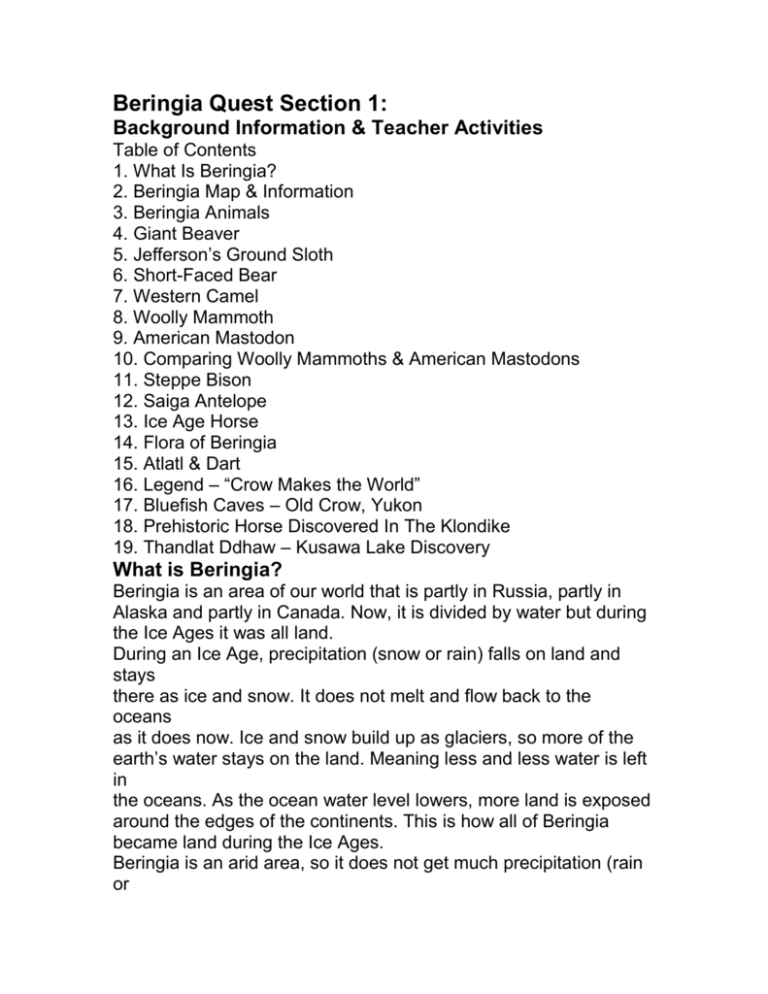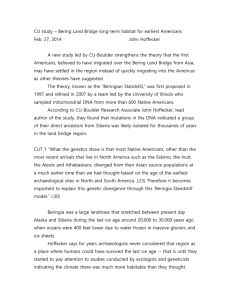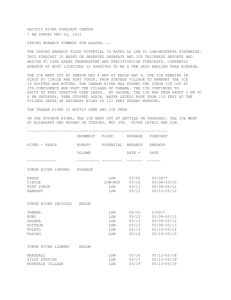Beringia Quest Section 1: Background Information & Teacher
advertisement

Beringia Quest Section 1: Background Information & Teacher Activities Table of Contents 1. What Is Beringia? 2. Beringia Map & Information 3. Beringia Animals 4. Giant Beaver 5. Jefferson’s Ground Sloth 6. Short-Faced Bear 7. Western Camel 8. Woolly Mammoth 9. American Mastodon 10. Comparing Woolly Mammoths & American Mastodons 11. Steppe Bison 12. Saiga Antelope 13. Ice Age Horse 14. Flora of Beringia 15. Atlatl & Dart 16. Legend – “Crow Makes the World” 17. Bluefish Caves – Old Crow, Yukon 18. Prehistoric Horse Discovered In The Klondike 19. Thandlat Ddhaw – Kusawa Lake Discovery What is Beringia? Beringia is an area of our world that is partly in Russia, partly in Alaska and partly in Canada. Now, it is divided by water but during the Ice Ages it was all land. During an Ice Age, precipitation (snow or rain) falls on land and stays there as ice and snow. It does not melt and flow back to the oceans as it does now. Ice and snow build up as glaciers, so more of the earth’s water stays on the land. Meaning less and less water is left in the oceans. As the ocean water level lowers, more land is exposed around the edges of the continents. This is how all of Beringia became land during the Ice Ages. Beringia is an arid area, so it does not get much precipitation (rain or snow). During the Ice Ages, there were always parts of Beringia that were cold but had very little snow or ice. The part of Beringia that was land during the Ice Ages is sometimes called the Land Bridge. People, plants and animals crossed from Asia to North America over this bridge. Some animals and plants also went from North America to Asia. Great herds of animals gathered in Beringia because they could find food. ---------------------------------------------------------------------Draw a picture showing what you think it would have been like in Beringia 15,000 years ago. Beringia Beringia is a landmass that remained generally ice free even during continental glaciations. It covered a distance of 3200 km. It included portions of three modern nations – Russia, the United States of America and Canada. The Bering Land Bridge originated at least 70 million years ago and was a dry land route for the movements of plants and animals and people between North America and Asia. Map of Beringia at the height of the last glaciation showing limits of glaciation and the location of archaeological sites of the late Ice Age. From R.E. Morlan “Beringia Research Note.” Beringia Animals Name some of the animals that lived in Ice Age “Beringia”. 1. ___________________________________________ 2. ___________________________________________ 3. ___________________________________________ 4. ___________________________________________ 5. ___________________________________________ 6. ___________________________________________ 7. ___________________________________________ 8. ___________________________________________ 9. ___________________________________________ 10. ___________________________________________ Draw a picture of your favourite Beringian animal. Giant Beaver The giant beaver is one of the largest rodents ever known. It could grow to be 2.5 metres long and weigh 218 kg. It was probably a distant cousin of our modern beaver. The giant beaver became extinct about 10,000 years ago. Some fossils have been found that are over 70,000 years old. They look like our present day beavers except for their size, their ridged teeth and perhaps their roundish muskrat-like tails. Their cutting teeth could be up to 15 cm. long. Judging from their teeth, they were herbivores (plant eaters) like the modern beaver. They lived in lodges. One was found that was 1.2 metres high and 2.4 metres in diametre. They seem to have preferred lakes and ponds bordered by swamps as their home. -------------------------------------------------------------------------------1. Use a ruler and draw a giant beaver’s cutting tooth in the space below. 2. Palaeontologists think the teeth were ridged to make them stronger. What do you think would happen if a giant beaver broke one of its teeth? (Clue: Find out about modern beavers). Jefferson’s Ground Sloth Jefferson’s Ground Sloth is one of the most unusual of North American Ice Age mammals. One of several species of sloths that lived in the Western Hemisphere, this one was named to honour U.S. President Thomas Jefferson, who was one of North America’s first palaeontologists. The giant ground sloth originated in South America and moved into North America about 5 million years ago. This sloth is known from Yukon and Alaska fossils 150,000 to 130,000 years old. Jefferson’s Ground Sloth was a longhaired, ox-sized mammal. It was 2.5 to 3 metres long and weighed more than one tonne. Giant sloths were plant-eaters. Their teeth were long, flattened pegs with ridges. Their curved front claws allowed them to hook down high leafy branches from trees. In the Yukon, giant sloth fossils have been found at Old Crow. They became extinct about 9,400 years ago. ----------------------------------------------------------------------------1. Look at pictures of modern day sloths. How were the giant sloths alike/different from the modern day species? _____________________________________________________ _________ _____________________________________________________ _________ _____________________________________________________ _________ _____________________________________________________ _________ _____________________________________________________ _________ _____________________________________________________ _________ _____________________________________________________ _________ Short-Faced Bear The short-faced bear was a mammal that lived in Beringia. It was probably a predator (a meat-eater) that may have attacked bison, deer, muskoxen, caribou, ground sloths and horses. It probably hunted alone except when there was a mother with cubs. The largest bears were nearly 1.5 metres tall when walking on four legs, and about 3.4 metres when on their hind legs. They could reach more that 4.3 metres that’s 1.2 metres higher than a basketball hoop. The short-faced bear has been extinct for more than 10,000 years. The spectacled bear of South America is the closest living relative of the North American short-faced bear. -------------------------------------------------------------------------------1. Circle the correct answer. Short-faced bears were – carnivores, omnivores, and herbivores. 2. Find a metre stick and measure the height of the bear when walking on four legs and when standing on two legs. How does it compare to the height of our classroom? Western Camel Most people do not know that camels started out in North America. The western camel lived in North America from 10,000 to 600,000 years ago. It probably lived in Beringia for only a short part of this time. It is now extinct. Scientists think that some western camels traveled into Asia when the land bridge was open during the Ice Ages. The descendants of these camels are the dromedary and Bactrian camels found in Africa and Asia today. Other North American camels moved into South America and are related to the llamas found there now. In life, the western camel looked like a dromedary – with one hump. However, its legs were much longer (about 1/5” more) and its head was longer and narrower. In all, it was about 3.5 metres tall. It was probably covered with long hair to keep it warm. It lived in herds, eating herbs, fruit and leaves as well as grasses. Pieces of bones from western camels have been found at PaleoIndian village sites. It was probably one of the animals hunted by them for food, skins and bones. -------------------------------------------------------------------------------Use a chart. Draw a western camel in the middle then the appropriate animals in the other two spaces. Use whatever books you need for pictures to copy from. Woolly Mammoth Woolly mammoths were animals that looked like elephants. They lived in northern parts of Europe, Asia and North America over 11,000 years ago. They are extinct. We know a lot about them because whole bodies have been found frozen in Siberia and Alaska. Early people in Europe drew pictures of them on cave walls. They had long shaggy coats of brown or black hair over fine, short underhair. They had dark gray skin and thick layers of fat that kept them warm. They ate grasses and shrubs. They chewed the tough food with broad flat teeth. In their life, they would grow 24 teeth, just like modern elephants. A fully-grown adult had 4 teeth when one tooth was worn down, another came forward from the back of its mouth to take its place. They had long curly tusks that were probably used for protection and to dig grasses from under ice and snow. The young mammoths were hunted by the Scimitar Cat, American Lion, and people (Paleo-Indians). The adult mammoths were hunted by the PaleoIndians. Their meat was eaten, the skins were used, and their bones and tusks were used to build houses and to make tools and jewelry. -------------------------------------------------------------------------------1. What could the Paleo-Indians have made from the mammoth’s skin? 2. What would they have used to sew with? American Mastodon Mastodons were large elephant-like animals. They have been extinct for about 9,000 years. Their remains have been found all over North America. They are often confused with the woolly mammoth. They were shorter in height but longer and heavier than the mammoth. They had straighter tusks and did not have a hump on their heads like the mammoth. Unlike mammoths who usually lived in open areas, mastodons seem to have liked being in forested and swampy areas. They ate leaves, twigs, cones, grasses, swamp plants and mosses. The remains of one mastodon had nearly 250 liters of plant material in its stomach. Mastodons were different colours of brown. They had long guard hair over a fine woolly layer. Some pieces of hair were found beside a skeleton in the northern United States. These hairs were from 7 cm to 18 cm long. Scimitar Cats preyed on young mastodons. Paleo-Indians hunted the young and the adults. All parts of the mastodon would have been used. -------------------------------------------------------------------------------Look at the pictures of the woolly mammoth and the American Mastodon. Write down the differences that you can see between the two animals. _____________________________________________________ _________ _____________________________________________________ _________ _____________________________________________________ _________ _____________________________________________________ _________ _____________________________________________________ _________ _____________________________________________________ _________ Steppe Bison The Steppe Bison lived during the Pleistocene Period (about 2 million To 10,000 years ago). It was one of the most common species from Eastern Beringia (unglaciated parts of Alaska, Yukon and Northwest Territories). Images of the Steppe Bison appear in Stone Age cave images in Europe. Preserved carcasses have also been found. Perhaps the most famous is “Blue Babe”, a nearly complete 8-9 year old male carcass, found at Pearl Creek, near Fairbanks, Alaska in 1979. The specimen was carbon dated to about 36,000 years ago. Blue Babe’s weight was estimated to be 700 800 kg. It was a rich, dark brown colour. Partial carcasses of other Steppe Bison have been found in the Yukon, Alaska and Siberia. Among the best preserved specimens are from bones found in the Old Crow Basin. The find includes skeletal parts, and skulls. Indications are that the Old Crow Steppe Bison died about 12,000 years ago. The Steppe Bison was characterized by its large size, long hindlegs and large horns. The horns had tips that curved back. The Steppe Bison lived mostly on low-growth herbs and grasses. The rapidly changing climate towards the end of the last glaciation resulted in the replacement of the steppe-like grassland range by boreal forest and tundra. These changing conditions and human and animal hunters most likely helped to accelerate the extinction of the Steppe Bison. Saiga Antelope Herds of Saiga Antelope crossed Beringia from Asia. The last known Saiga in Canada was about 12,200 years ago. When the Ice Age ended, it is thought that Saiga Antelopes did not adapt to the changed habitat and died out in North America. It is not extinct. There are two groups living in Asia. The group in China is endangered. The two Saiga Antelope mounts in the Beringia Interpretive Centre came from the Russian herd. It is about the size of a large dog, with creamy yellow or whitish hair. The hair is hollow, like a caribou’s, so keeps it warm in cold weather. Its long nose helps it breathe safely in really cold weather as well as when its dusty. It has large eyes and excellent eyesight. Only the males have horns. Their age can be told by counting the rings on the horns. The Saiga Antelope is a herbivore. It eats many kinds of plants. Its’ habitat is on open flat windy land where it can find the food it likes and have a good chance to see any predators approaching. The wind keeps insects away and stops snow from piling too deeply over the grasses in winter. Its’ main enemies are wolves and people. To escape, the adult Saiga can run at speeds of up to 75 km. an hour. Newborns, usually twins, are hunted by foxes, stray dogs, eagles and ravens. -------------------------------------------------------------------------------Colour the picture of the Saiga Antelope. Remember to check the colour before you start. Ice Age Horse Equus lambei was a small horse about the size of a modern pony. It had a long, flowing, blondish mane. During the last Ice Age, it roamed in large numbers in the area now known as the Yukon and Alaska. It shared its habitat with the woolly mammoth, the scimitar cat, short-faced bears, the steppe bison and the camel. The Ice Age Horse crossed the Bering Land Bridge into Asia. The changing conditions brought about by the last glaciation may have caused the extinction of the horse in North America more than 10,000 years ago. The domesticated horse found in the Old World was reintroduced into the New World by European explorers. ----------------------------------------------------------------------------- Some Points To Consider: Compare the “Ice Age Horse” to its’ modern day cousin. Compare size, habitat and food. Which group of Europeans introduced the horse to North America? What were the early horses used for? Flora of Beringia The vegetation of Ice Age Beringia was a mosaic of different plants. Today it is possible to learn about this vegetation by studying preserved pollen and the remains of the plants themselves. These remains are often found frozen in glacial mucks and lake bottoms. Some remains have been found in the stomachs of mummified Ice Age animals, such as the mammoth and bison. In some instances, preservation of the plant remains is remarkable. Scientists have been able to germinate and grow healthy plants from 10,000 year old lupine seeds that were discovered from a prehistoric lemming nest found in the Sixty Mile River area of the Klondike. An analysis of the stomach contents from mammoths plus other research material, indicates that the following plants were in existence at the time of Beringia: Columbine Sage Yarrow Cinquefoil Jacob’s Ladder Arctic Lupine Wind Flower Balsam Poplar Dwarf Willow Dwarf Birch Sedges Cotton-grass From your school library take out a book on Yukon plants and wildflowers. Find the plants listed in the boxes below and draw a picture of what the plant looks like. Cinquefoil Jacob’s Ladder Cotton-grass Arctic Lupine Atlatl and Dart The Atlatl is a prehistoric hunting tool. It is device used to throw a lightweight spear or dart. The Atlatl throwing board consists of a stick about 2 feet long, with a handgrip at one end and a “spur” at the other end. The spur is a point that fit into a space at the back of a dart that is 4-6 feet long. The dart is held parallel to the throwing board with the tips of the fingers and is thrown in a sweeping motion, much like a tennis serve. The Atlatl was a powerful, accurate weapon. It was used long before the bow and arrow; in fact it is believed that the Atlatl was in use for more than 30,000 years. Atlatl is an Aztec word meaning “spear thrower”. In Australia it is called “Woomera” by the Aboriginal people. The Atlatl originated in Europe and was brought to North America about 12,000 years ago by hunters of the last Ice Age. It was used to kill ancient bison and mammoth. In the hands of an expert, the dart can hit a target up to 100 yards away. Here in the Yukon, parts of an Atlatl were found in the Kusawa Lake area in 1997. More discoveries continue to be made each summer as the glacial ice slowly melts in parts of the Yukon. Crow Makes The World Adapted from Tommy McGinty (Legros 1984 Tape 129, T. McGinty Tape 14) That time, Crow can be a man or can fly around. He knew the water was going to rise, floods were coming. He killed a nighthawk and a small duck and skinned them. He kept those skins with him. Then it started to rain and rain and rain. Crow fly around all over the place. After a while, he got tired and rested on a high hill. Water comes up and up. Crow goes inside the nighthawk skin then. Just his nose sticks out of an airhole. Nighthawks have a white mark there, where Crow’s nose poked through. Water came right clean up then – covered everything. Crow stayed inside the nighthawk skin a long time but the water never goes down. A long time passed and finally the water started to drop a little. Crow come out and got into the duck skin then, and started to float around. No land yet. He say, “Must be I made a mistake. I left that duck skin behind me!”. Then he come to bare rock. One piece sticking out there. Seal and her baby lying on top of that rock. Crow wish they don’t look at him. He flies behind. Seal doesn’t see him. He grabs her baby. Told her, “I’m going to take this baby away from you. I’m going to fly away”. Seal said, “That’s my baby. I don’t want to lose it”. They talk then. Crow ask her where that land comes from that she’s sitting on. “I’ll get you some if you give me back my baby,” Seal said. Crow answer “That’s what I want”. She got land for Crow, went underwater. She kept doing that. Some pieces have trees, some have sandbar and driftwood. Pretty soon she brought up the whole thing. Then he gave baby back to Seal. They go back then. Crow arranged all the different kinds of land; put driftwood and sand between, and fixed them all together. Put it all around that rock, to make the world round. Then he jumped on it. “Non kie, non kie” – that means “come right around, join together”. Crow walked around, then fly around. He’s thirsty and hungry. Now he’s got lots of land but no water. Pretty soon he find one man – Tundye – Eagle friend. Only one who has water and fish. Crow say, “Oh gee, brother-in-law, I’m pretty dry. Give me some water”. Eagle said, “No. I won’t give you any water”. And he stuck his head down that hole where the water is, hole about a foot and a half wide. Crow walking around, don’t know what to do. Thinks maybe he should make war to that man. Then he’d run away and Crow could steal his water. Crow tell Eagle he’s going to go in the bush – look around for water. So he went, took leaves and put them together – all kinds of fancy leaves. Made birds with that. Told them to fly around. Next he made Tetza too (small owl) and told him, “You’re going to be my nephew – you’re going to help me”. Then he made the birds that eat fish. Told them: “This man there, he’s got lots of fish and lots of water. We’re going to scare that man, take all his fish and all that water”. Birds turn to man then. Grab clubs – ready for war. Crow went back to Eagle then and tells him “Tundye –I dream bad, big war coming to us; me, I died. You, you run for your life. Don’t come back.” Then he ask Eagle again to give water. Eagle say no again. Crow lay down on the other side of the water then. “Nothing to drink, I’m going to die now”. Crow die then. Soon, a big war come to Eagle. Eagle hear that. “En-do-a-a-a-a!” (Uncle) Fish eater birds come. WHOOMF, WHOOMF, WHOOMF! Eagle run away. Run back, get some water and fish to eat. Too many coming. He run away again. Take off. They chase him. Crow jump up then, stick his head in hole and start drinking. Fish, water, everything. Pretty soon he has enough inside his stomach. Fish coming right out of his mouth. Owl and fish eater come behind him, drink too. Pretty soon it’s nearly empty. Crow said, “Come behind me”. They fly off. Crow shake a little stick, from that the water drop. Put fish there. That’s going to be a fish lake. Tell fish to stay there forever. Put more water for channels, and with the stick mark where the channels and river going to run. After he emptied his stomach, his crew, owl and fish eater go off to make their own living. Crow come to ocean. Crow talk to himself: “Gee, I did pretty good. I make good land. Lots of water and fish, animals and birds – keep me happy”. From there Crow travel again . . . Bluefish Caves – Old Crow, Yukon The Bluefish caves are an archaeological site located in the northern Yukon, 50 kilometers southwest of Old Crow. The 3 caves, actually limestone shelters, occur at the base of a limestone bedrock ridge, along the mid-course of the Bluefish River, about 200m above the valley floor. The caves reveal the oldest evidence of human occupation in North America. Preserved within the sediments are the artifacts that have provided information which has allowed scientists to reconstruct the history of the caves in surprising detail. Research being done at the Bluefish Caves, is led by archaeologist Jacques Cinq-Mars of the Archaeological Survey of Canada, Canadian Museum of Civilization. Initial research was carried on in the 1970’s and 1980’s. Although the soil layers at Bluefish Caves are little more than a metre thick, they preserve a record of events and past environments, spanning approximately 24,000 years. The soil layers or stratigraphy exposed in the excavations have remains of past vegetation and the bones of the Ice Age mammals that once roamed in the area. Pollen and plant remains of the loess (wind-blown silt) layers in the caves reflect a vegetative cover dominated by grasses and herbs, the typical vegetation of the glacial maximum. The organic rubble layers above preserve a sequence marked first by a rise in shrub birch, followed by spruce, as forests once again moved into the northern Yukon as temperatures and rainfall increased at the end of the Ice Age. The bones of animals in the loess layer are principally those of Ice Age species: horse, bison, mammoth, wapiti, saiga antelope and caribou. Dates on a horse femur, a mammoth scapula and a mammoth limb bone provided dates of 13,000, 15,500 and 24,000 years before present, indicating use of the cave by both animals and people in the last millennia of the glacier period. Meticulous microscopic examination of the bones from the Bluefish Caves has revealed butchering and cut marks on bone, including the bone of mammoth, caribou and horse. There is no sign of human use of the cave after the end of glaciation. In addition to larger Ice Age mammals, remains of smaller carnivores, rodents, birds and fish were also found in the Caves. Palynology, the study of ancient pollens, can be used to reconstruct past Beringian vegetation and climate. Based on samples obtained from one of the Bluefish caves, the vegetation represented by the lower layer is that of a treeless, herb-rich tundra habitat that supported Ice Age fauna. The middle layer of vegetation marks a change towards a more humid climate and vegetation. The top layer of vegetation corresponds to the end of the Ice Age. It shows the establishment, at about 10,000 years ago, of the spruce forests that are found today around the Bluefish Caves. Prehistoric Horse Discovered in the Klondike In September of 1993, children playing on a placer claim on Last Chance Creek near Dawson City, discovered a horse’s shoulder bone with a scrap of flesh still clinging to it. They told their fathers of the find and the parents subsequently found the freeze-dried foreleg of the horse. Yukon archaeologists were alerted. At first some archaeologists thought the bones might be that of a horse that had died at the time of the Klondike Gold Rush (1898). The miners insisted that the carcass was much older. The carcass was transported to the Canadian Museum of Nature in Ottawa. Dr. Dick Harington, a wellknown palaeontologist, sent a sample of the bone off to Miami for radiocarbon dating. Tests done on the bone confirmed the miners’ suspicions. The carcass was identified as the extinct Yukon horse or Ice Age horse. It lived over 26,000 years ago. The carcass will help tell scientists about both the Ice Age Horse and the environment that it lived in. The pelt showed an animal about the size of a modern day pony. It had a long, flowing, blondish mane. At the moment, a number of scientific tests and experiments are being performed on the carcass. Scientists will examine the horse’s hair to see if it gave better insulation that the hair of the modern day horse. The carcass itself will be examined for claw and tooth marks. This will tell whether or not the horse had fallen victim to a predator. The pelt will be examined for signs of parasites. Intestinal contents may give an idea of the horse’s diet. An intestinal analysis of the carcass may give scientists and archaeologists information about human life during the Ice Age period. Thandlat Ddhaw – Kusawa Lake Discovery On August 31, 1997, an accidental discovery of caribou fecal pellets and a caribou antler, was made on a permanent snow patch on Thandlat Ddhaw in the Kusawa Lake area of Southern Yukon. The discovery was of immediate interest as this is an area where caribou are not currently found. The last time caribou were seen in the area was in 1932. The caribou fecal pellets on the surface of the snow were the result of a recent and rapid melting of the alpine snow patch. The pellets were likely deposited in the 19th century. Also discovered, on the edge of the snow patch, was the end of a feathered dart or arrow shaft. The site was revisited on September 12, 1997. An ice core auger was used to collect samples of subsurface ice deposits. Caribou fecal pellets were found throughout the core sample. The ice core was sent to the University of Toronto for radiocarbon dating. A small portion of the wooden dart fragment was also submitted for radiocarbon dating. The results were amazing! The caribou fecal pellets were dated at 2450 BP (Before Present). It is possible that the Thandlat snow patch contains a record of ice with layers of caribou fecal pellets dating back in time more than 4000 years. The fragment of the wooden dart or arrow shaft proved to be a rare example of organic hunting technology of the mid-Holocene period. It provided evidence that prehistoric hunters used the Thandlat area for hunting. It was dated at 4360 BP. The Thandlat site is located about a half day’s hike from Kusawa Lake. Traditionally Kusawa Lake was an important summer fishing lake. It was also the site of annual trading between local Kwanlin Dun, Carcross/Tagish and Champagne and Aishihik First Nations. Research on the “Kusawa Lake” find is still ongoing. It is highly likely that more organic remains will be found. The rapidly melting snow patch could provide a unique opportunity to learn more about ancient hunters and the caribou they hunted.









